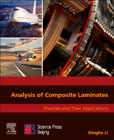
Composite Laminated: Theories and Their Applications presents the latest methods for analyzing composite laminates and their applications. The title introduces the most important analytical methods in use today, focusing on fracture, damage, multi-physics and sensitivity analysis. Alongside these methods, it presents original research carried out over two decades on laminated composite structures and gives detailed coverage of laminate theories, analytic solutions and finite element models. Specific chapters cover An introduction to composites, Elasticity, Shear, State space theory, Layerwise theories, The extended layerwise method, Fracture and damage mechanics, Multi-physical fracture problems, Analytical methods of stiffened sandwich structures, Progressive failure analysis, and more. This volume offers a comprehensive guide to the state-of-the-art in the analysis and applications of composite laminates, which play a critical role in all types of engineering, from aerospace to subsea structures, including in medical prosthetics, circuit boards and sports equipment. Presents a guide to the analysis and application of advanced composite materials Gives detailed exposition of plate/shell theories and their implementation in finite element code architecture Considers the robustness, effectiveness and applications aspects of laminated plate/shell methods Gives hands-on experience of code architecture, providing composite analysis software which can be plugged in to commercial applications Presents experimental research alongside methods, laminate theories, analytic solutions, and finite element models INDICE: 1. An introduction of composite is presented, including history and applications, constituents and basic analysis schemes2. Elasticity fundaments used in this book are briefly introduced, including the fundamental equations of elasticity, general Hook's low and energy principles of elasticity3. Shear deformation theories are introduced, including Classical Laminated Plate Theory (CLPT), First-order shear deformation theory (FSDT), High-order Shear Deformation Theory (HSDT) and Higher-order Shear Deformation Theory (HrSDT)4. State space theory is introduced. The Hamilton canonical equation is deduced from the differential and variational schemes for the laminated composite plates and shells. The solving methods are developed based onexact solution, finite element method and meshless method. In addition, the state space theory is extended into bonding imperfection of composites5. Layerwise theories are introduced, including Integrate layerwise methods and Discrete layerwise theories.6. Extended layerwise method is established for the composite laminated beams, plates and shells with multiple delaminations and transverse cracks7. The fracture and damage mechanics of composites 8. The multi-physical fracture problems are presented, including thermo-mechanical, piezoelectric, chemo-mechanical and chemo-thermomechanicalcoupling9. The analysis methods of stiffened and sandwich structures are studied based on state space theory, layerwise method and extended layerwise method10. The progressive failure analysis problems of composite laminated plates, stiffened plates and sandwich plates are studied by the continuous damage mechanics and layerwise theory11. The static responses and frequencies sensitivity analysis of laminated composites based on state space theory, layerwise method are discussed, including composite plates, stiffened plate/shells and sandwich plates
- ISBN: 978-0-323-90804-7
- Editorial: Elsevier
- Encuadernacion: Rústica
- Páginas: 542
- Fecha Publicación: 11/03/2022
- Nº Volúmenes: 1
- Idioma: Inglés
